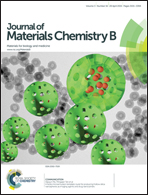A ratiometric lysosomal pH probe based on the naphthalimide–rhodamine system†
Abstract
In this study, a novel ratiometric pH probe RNL based on fluorescence resonance energy transfer (FRET) was well developed. It was fabricated by integrating the naphthalimide moiety as an FRET donor with the rhodamine moiety as an FRET acceptor. Meanwhile, 4-(2-aminoethyl)morpholine, which was a lysosome-locating group, was introduced. The sensing mechanism was the integration of PET and FRET processes and the comprehensive effect led to the simultaneous intensity enhancement of naphthalimide and rhodamine along with the pH value decrease. With a pKa of 4.82, the fluorescence intensity ratio (I529/I580) of the probe changed significantly within the pH range from 4.50 to 5.50. The probe showed excellent selectivity among various metal cations, amino acids and ATP. Moreover, RNL has been successfully applied in HeLa cells, and the results demonstrated that it could be used to detect lysosomal pH changes. The probe could also selectively stain lysosome in HeLa cells. Besides, the probe exhibited low cytotoxicity and satisfactory photostability in living HeLa cells.


 Please wait while we load your content...
Please wait while we load your content...